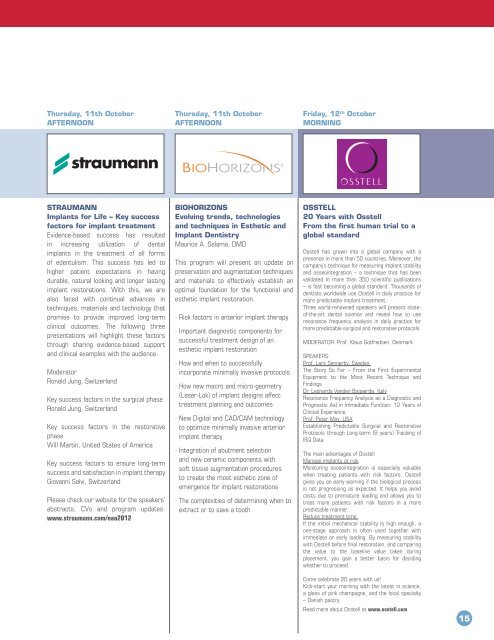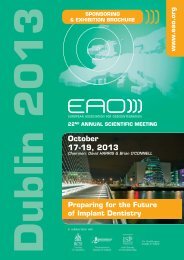October 10-13, 2012 - EAO
October 10-13, 2012 - EAO
October 10-13, 2012 - EAO
You also want an ePaper? Increase the reach of your titles
YUMPU automatically turns print PDFs into web optimized ePapers that Google loves.
Thursday, 11th <strong>October</strong><br />
AFTERNOON<br />
STRAUMANN<br />
Implants for Life – Key success<br />
factors for implant treatment<br />
Evidence-based success has resulted<br />
in increasing utilization of dental<br />
implants in the treatment of all forms<br />
of edentulism. This success has led to<br />
higher patient expectations in having<br />
durable, natural looking and longer lasting<br />
implant restorations. With this, we are<br />
also faced with continual advances in<br />
techniques, materials and technology that<br />
promise to provide improved long-term<br />
clinical outcomes. The following three<br />
presentations will highlight these factors<br />
through sharing evidence-based support<br />
and clinical examples with the audience.<br />
Moderator<br />
Ronald Jung, Switzerland<br />
Key success factors in the surgical phase<br />
Ronald Jung, Switzerland<br />
Key success factors in the restorative<br />
phase<br />
Will Martin, United States of America<br />
Key success factors to ensure long-term<br />
success and satisfaction in implant therapy<br />
Giovanni Salvi, Switzerland<br />
Please check our website for the speakers’<br />
abstracts, CVs and program updates:<br />
www.straumann.com/eao<strong>2012</strong><br />
Thursday, 11th <strong>October</strong><br />
AFTERNOON<br />
BIOHORIZONS<br />
Evolving trends, technologies<br />
and techniques in Esthetic and<br />
Implant Dentistry<br />
Maurice A. Salama, DMD<br />
This program will present an update on<br />
preservation and augmentation techniques<br />
and materials to effectively establish an<br />
optimal foundation for the functional and<br />
esthetic implant restoration.<br />
· Risk factors in anterior implant therapy<br />
· Important diagnostic components for<br />
successful treatment design of an<br />
esthetic implant restoration<br />
· How and when to successfully<br />
incorporate minimally invasive protocols<br />
· How new macro and micro-geometry<br />
(Laser-Lok) of implant designs affect<br />
treatment planning and outcomes<br />
· New Digital and CAD/CAM technology<br />
to optimize minimally invasive anterior<br />
implant therapy<br />
· Integration of abutment selection<br />
and new ceramic components with<br />
soft tissue augmentation procedures<br />
to create the most esthetic zone of<br />
emergence for implant restorations<br />
· The complexities of determining when to<br />
extract or to save a tooth<br />
Friday, 12 th <strong>October</strong><br />
MORNING<br />
OSSTELL<br />
20 Years with Osstell<br />
From the fi rst human trial to a<br />
global standard<br />
Osstell has grown into a global company with a<br />
presence in more than 50 countries. Moreover, the<br />
company’s technique for measuring implant stability<br />
and osseointegration – a technique that has been<br />
validated in more than 350 scientifi c publications<br />
– is fast becoming a global standard. Thousands of<br />
dentists worldwide use Osstell in daily practice for<br />
more predictable implant treatment.<br />
Three world-renowned speakers will present stateof-the-art<br />
dental science and reveal how to use<br />
resonance frequency analysis in daily practice for<br />
more predictable surgical and restorative protocols.<br />
MODERATOR: Prof. Klaus Gotfredsen, Denmark<br />
SPEAKERS:<br />
Prof. Lars Sennerby, Sweden<br />
The Story So Far – From the First Experimental<br />
Equipment to the Most Recent Technique and<br />
Findings<br />
Dr. Leonardo Vanden Bogaerde, Italy<br />
Resonance Frequency Analysis as a Diagnostic and<br />
Prognostic Aid in Immediate Function: 12 Years of<br />
Clinical Experience<br />
Prof. Peter Moy, USA<br />
Establishing Predictable Surgical and Restorative<br />
Protocols through Long-term (8 years) Tracking of<br />
ISQ Data<br />
The main advantages of Osstell<br />
Manage implants at risk<br />
Monitoring osseointegration is especially valuable<br />
when treating patients with risk factors. Osstell<br />
gives you an early warning if the biological process<br />
is not progressing as expected. It helps you avoid<br />
costs due to premature loading and allows you to<br />
treat more patients with risk factors in a more<br />
predictable manner.<br />
Reduce treatment time<br />
If the initial mechanical stability is high enough, a<br />
one-stage approach is often used together with<br />
immediate or early loading. By measuring stability<br />
with Osstell before fi nal restoration, and comparing<br />
the value to the baseline value taken during<br />
placement, you gain a better basis for deciding<br />
whether to proceed.<br />
Come celebrate 20 years with us!<br />
Kick-start your morning with the latest in science,<br />
a glass of pink champagne, and the local specialty<br />
– Danish pastry.<br />
Read more about Osstell at www.osstell.com<br />
15



